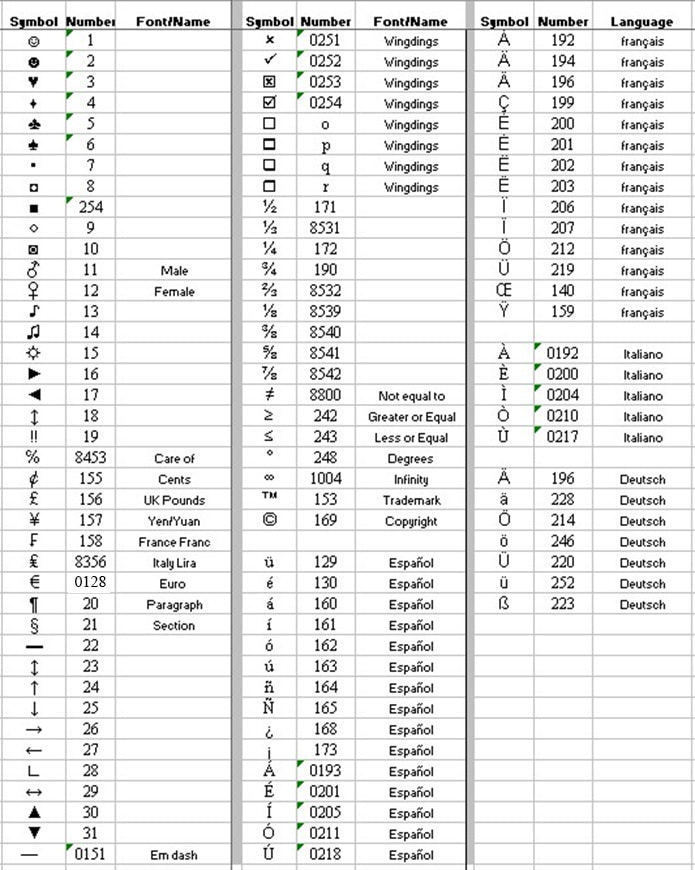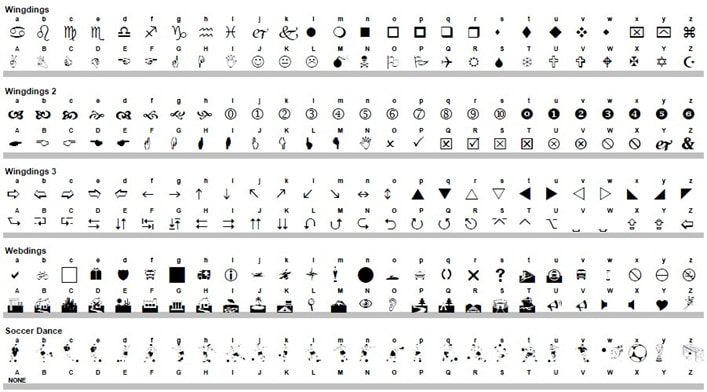
I've written a mess of articles over the years. These are the ones still available on the web. In some cases the titles are a bit clumsy - I had to take the title and write on the subject as it was written. Many of them have the particular structure dictated by the outlet.
Click on the title to go to the article.
0 Comments
Want to quickly insert a symbol / character into a doc, spreadsheet, email, etc., but don't want to scroll through a table searching for the right symbol? Using the ALT key with a combination of numbers can make the process a bit quicker and simpler. Here's how:
▀
(This only works with number keys on the number pad, it won't work with the numbers at the top on the keyboard.) There are LOTS more symbols available, including letters and symbols from other languages - and most even work in emails and websites. ALT-3 = ♥ ALT-160 = á ALT-168 = ¿ ALT-26 = → ALT-164 = ñ ALT-173 = ¡ Some fonts don't include all the symbols. Arial or Times Roman seem to be the best fonts to use for inserting a symbol. You may need to increase the font size to make the character more visible. Don't forget to reset the font size as you continue to type your document. There are special character that may be used in specific professions, like the § (ALT-21) character used in legal documents; or the Euro € (ALT-0128), yen character ¥ (ALT-157) used in international finance. There are plenty of websites with ALT-key charts. You can Google "alt-key chart" to find them. Here's a link: www.alt-codes.net Charts are also often included in the index of software manuals. It's handy to memorize a few of the number combinations and/or keep a chart nearby so you can insert them quickly - keep a chart of most-used symbols on your desk. Here's mine: There are also symbol-only fonts like Wingdings. Many are probably already on our computer. For example, to insert a shadowed check box q change the font to Wingdings (16pt) and type a lower case q. Then change the font back to Times New Roman (12pt) or whatever font you’ve been using. The symbols on lower case letters may be different than on upper case. Here’s my sample sheet: TIPS:
Some symbols and fonts won’t translate when printed to a PDF file. They will show as only an unrecognizable symbol. There are tons of fun fonts available on the web, many or which are specific to a sport or activity like “Soccer Dance” in the above sample. Many of them are free. Google “symbol fonts” and you’ll get plenty of hits. Here are some links: http://www.fontspace.com/category/symbols http://www.1001fonts.com/fonts_overview.html?page=1&category_id=6 http://www.fontcenter.com/categories/Dingbat_and_Symbol/index.html Forget all the silly hype about “chemicals” in your food. Food poisoning can, in fact, kill you! According to the CDC, roughly 48 million Americans get sick from food-borne illness each year; 128,000 people go to the hospital and 3,000 die annually from food-borne illness outbreaks. In 2013 the CDC evaluated nearly 4,600 food-borne disease outbreaks from 1998 to 2008 with information on both the specific food causing the outbreak and the specific type of illness. They found that food-borne illness is accounted for in 17 food categories:
Food handlers who don’t wash their hands properly are often to blame for norovirus and other outbreaks. Other culprits are people in their own kitchens. Most people are blissfully unaware of the dangers of bacterial contaminants in food. Linda Larson of FoodPoisoningBulletin.com lists the following mistakes commonly made in the kitchen:
REFERENCES Kathleen Doheny, "Most Common Foods for Foodborne Illness: CDC Report," Medscape, January 30, 2013, accessed September 21, 2017, http://tinyurl.com/Medscape-FoodPoison. J. A. Painter et al., "Centers for Disease Control and Prevention," CDC: Emerging Infectious Diseases, March 2013, accessed September 21, 2017, http://tinyurl.com/CDC-FoodPoison2013. Giorgia Guglielmi, "Your Kitchen Sponge Harbors Zillions of Microbes. Cleaning It Could Make Things Worse," Science | AAAS, July 28, 2017, accessed July 31, 2017, http://tinyurl.com/SciMag-GermyKitchenSponges. Linda Larson, "Ten Common Food Safety Mistakes," Food Poisoning Bulletin, April 06, 2017, accessed April 06, 2017, http://tinyurl.com/FdPoisBull-10Mistakes. Lyndsey Matthews, "Science Explains Why Picking the Mold Off Your Bread Doesn't Work," Popular Mechanics, April 21, 2017, accessed July 26, 2017, http://www.popularmechanics.com/home/food-drink/a26184/moldy-bread-safety/.  Want more? Buy the book: Scam-Proof: Good Information & Critical Thinking for an Evidence-Based Life. Amazon - $1.99 Kindle, $6.25 paperback  Credit: Jupiterimages/Polka Dot/Getty Images Credit: Jupiterimages/Polka Dot/Getty Images Nothing conveys a warm, homey atmosphere in a room than a handcrafted afghan or throw. They can be as simple as a quick, single crochet striped lap throw or as complex as a popcorn stitch blanket. The Rose in Bloom is a favorite with Victorian decor fans and evokes warm memories of Grandma’s house. This afghan is made from 70 square motifs, each with flower petals, leaves and soils. Because it is made with squares, this afghan is a very convenient project to work on anywhere. The colors of yarn create a “garden” of flowers and can be worked as white roses, American Beauty roses or yellow and pink Peace roses. Skill
Motif: Petals Step 1 - Make 70 motifs. Beginning at center with B, chain 6; join with a slip stitch to form a ring. Round 1 (Right Side): [Single crochet in ring, chain 5] 8 times – 8 chain -5 loops. Round 2: (Single crochet, half double crochet, double crochet, half double crochet, single crochet) in each ch-5 loop around – 8 petals. Round 3: Holding petal forward, single crochet in first single crochet of Round 1, chain 4, * single crochet in next single crochet of Round 1 between petals, chain 4; repeat from * around – 8 chain-4 loops. Round 4: (Single crochet, half double crochet, 3 double crochet , half double crochet, single crochet) in each chain-4 loop around – 8 petals. Round 5: Holding petal forward, single crochet in first single crochet of Round 3, chain 4, * single crochet in next single crochet of Round 3 between petals, chain 4; repeat from * around – 8 ch-4 loops. Round 6: (Single crochet, half double crochet, 5 double crochet , half double crochet, single crochet) in each chain-4 loop around; join with a slip stitch in first single crochet – 8 petals. Fasten off. For the Peace Rose variant attach color D to last stitch of each petal of the center two rows of petals. Create edging by working 1 slip stitch in each stitch of each petal. Motif: Leaves and Soil Step 1 - Explanation of leaf stitches:
Round 7 (Leaves) Attach color C in third double crochet of any petal on Round 6, (Begin 3-double crochet cluster, chain 2, 3-double crochet cluster) in same double crochet; chain 3, * (3-triple cluster, chain 4, 3-double-triple cluster, chain 4, 3-triple cluster) in third double crochet of next petal for corner. Chain 3, (3-double crochet cluster, chain 2,3-double crochet cluster) in third double crochet of next petal; chain 3; repeat from * twice more; (3-triple crochet cluster, chain 4, 3-double triple cluster, chain 4, 3-double triple cluster) in third double crochet of next petal for corner; chain 3; join in top of begin 3-double crochet cluster. Fasten off. Round 8 (Soil): Attach A to top of 3-double triple cluster of any corner, chain 3 (counts as a double crochet ), 2 double crochet in same stitch ; 3 double crochet in each of next 5 chain spaces; * (3 double crochet , chain 3, 3 double crochet ) in top of next 3-double triple cluster for corner; 3 double crochet in each of next 5 spaces; repeat from * twice more; (3 double crochet , chain 3) in same stitch as beginning chain-3; join in third chain of beginning chain-3 = 84 double crochet stitches. Round 9: chain 3; * double crochet in each double crochet across to next corner chain-3 space, (3 double crochet, chain 3, 3 double crochet ) in corner space; repeat from * around; join in third chain of beginning chain-3 = 108 double crochet stitches. Fasten off. Finishing, Border and Blocking Step 1 With color A (the soil color) and working in back loop only of each double crochet and chain, sew motifs together in 10 rows of 7 motifs each. Weave in ends of yarn. If desired, dab a tiny drop of fabric glue or hot glue and allow to dry overnight to hold woven ends in place. Step 2 For the border, attach A in double crochet preceding any corner space; chain 3, (3 double crochet, chain 3, 3 double crochet ) in corner space, double crochet in each stitch across to next corner; * (3 double crochet , chain 3, 3 double crochet ) in corner space, double crochet in each stitch across to next corner, repeat from * around, join in third chain of beginning chain-3. Fasten off. To block or shape the afghan, wash the finished afghan in the washing machine on the gentle cycle. Do not dry in dryer. Cut a piece of cardboard a few inches larger than the desired length and width of the finished afghan. While the afghan is damp, lay it flat on the cardboard, smooth and shape with straight sides, and pin it in place. Allow to completely dry. Tips
Photo Prints:
TV and Video Displays:
Medicinet.com defines the placebo effect as
It’s the kiss a mom plants on her toddler’s “boo-boo.” This could also be called the power of positive thinking - nothing new. The Talmud, the ancient compendium of Jewish thought, said, "Where there is hope, there is life." In other words, thinking positive. Science has been aware of the placebo effect since at least the 1950s. Anesthesiologist Henry Beecher published his pioneering meta-analysis of 26 studies, “The Powerful Placebo,” in 1955. Beecher concluded that an average of 32% of patients responded to placebo, receiving measurable physiological effects. The study participants exhibited increased pulse rate, increased blood pressure, and faster reaction speeds, when told they have taken a stimulant. When participants were told they had taken a sleep-producing drug, they had the opposite effects. Study into the placebo effect is ongoing. There are whole departments at prestigious teaching hospitals dedicated to the study of placebos. Studies are continuing to show that humans react positively to a charismatic healer even if that healer gives the patient absolutely nothing. After all, the word “placebo” comes from the Latin for “I shall please.” Researchers are studying the mechanism by which placebo effect works. In a 2017 study Dr Marian van der Meulen, neuropsychologist at the University of Luxembourg, explained,
Interestingly enough, people can experience the placebo effect even when they know they’re receiving a fake medication or procedure. Dr. Ted J. Kaptchuk, a professor of medicine at Harvard Medical School and director of the Harvard-wide Program in Placebo Studies and the Therapeutic Encounter (PiPS) at Beth Israel Deaconess Medical Center in Boston, has been studying these “open-label placebos,” for several years.
Of course, placebos don’t work to lower cholesterol or cure cancer, but they can work for symptoms like pain, nausea, or fatigue. And the longer the trial, the greater the placebo effect. This is becoming a problem in studies because subjects in clinical trials often experience a higher response to legitimate drugs than they should, skewing results of studies. Oddly enough, this seems to be happening more in the U.S. than in other countries. However, most patients can’t control their own placebo response very well. In other words, people can’t just “think positively” and treat their own ailments very effectively. It usually requires some kind of healer or doctor or guru to administer the “drug” for the placebo response to be noticeable. REFERENCES University of Luxembourg, "Pain, Emotions and the Placebo Effect," ScienceDaily, August 29, 2017, accessed August 30, 2017, http://tinyurl.com/SciDaily-Placebo Mallika Marshall, MD, "A Placebo Can Work Even When You Know It's a Placebo," Harvard Health Blog, June 23, 2016, accessed July 30, 2017, http://healthHarvard-Placebo. Peter Dockrill, "The 'Placebo Effect' Is Getting Even Stronger With Time, Study Finds," ScienceAlert, October 8, 2015, accessed July 30, 2017, http://tinyurl.com/SciAlert-placeboStronger. Quora, "The Power And Problems Of The Placebo Response," Forbes, March 23, 2017, accessed July 30, 2017, http://tinyurl.com/Forbes-PlacebPowrProb. Jennifer Jo Thompson, Cheryl Ritenbaugh, and Mark Nichter, "Reconsidering the Placebo Response from a Broad Anthropological Perspective," Culture, Medicine and Psychiatry, March 2009, accessed July 30, 2017, https://www.ncbi.nlm.nih.gov/pmc/articles/PMC2730465/. Want more? Buy the book: Scam-Proof: Good Information & Critical Thinking for an Evidence-Based Life. Amazon - $1.99 Kindle, $6.25 paperback |
Archives
July 2024
Categories
All
|




 RSS Feed
RSS Feed